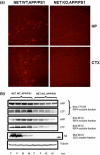Targeting norepinephrine in mild cognitive impairment and Alzheimer's disease
- PMID: 23634965
- PMCID: PMC3706916
- DOI: 10.1186/alzrt175
Targeting norepinephrine in mild cognitive impairment and Alzheimer's disease
Abstract
The Alzheimer's disease (AD) epidemic is a looming crisis, with an urgent need for new therapies to delay or prevent symptom onset and progression. There is growing awareness that clinical trials must target stage-appropriate pathophysiological mechanisms to effectively develop disease-modifying treatments. Advances in AD biomarker research have demonstrated changes in amyloid-beta (Aβ), brain metabolism and other pathophysiologies prior to the onset of memory loss, with some markers possibly changing one or two decades earlier. These findings suggest that amyloid-based therapies would optimally be targeted at the earliest clinically detectable stage (such as mild cognitive impairment (MCI)) or before. Postmortem data indicate that tau lesions in the locus coeruleus (LC), the primary source of subcortical norepinephrine (NE), may be the first identifiable pathology of AD, and recent data from basic research in animal models of AD indicate that loss of NE incites a neurotoxic proinflammatory condition, reduces Aβ clearance and negatively impacts cognition - recapitulating key aspects of AD. In addition, evidence linking NE deficiency to neuroinflammation in AD also exists. By promoting proinflammatory responses, suppressing anti-inflammatory responses and impairing Aβ degradation and clearance, LC degeneration and NE loss can be considered a triple threat to AD pathogenesis. Remarkably, restoration of NE reverses these effects and slows neurodegeneration in animal models, raising the possibility that treatments which increase NE transmission may have the potential to delay or reverse AD-related pathology. This review describes the evidence supporting a key role for noradrenergic-based therapies to slow or prevent progressive neurodegeneration in AD. Specifically, since MCI coincides with the onset of clinical symptoms and brain atrophy, and LC pathology is already present at this early stage of AD pathogenesis, MCI may offer a critical window of time to initiate novel noradrenergic-based therapies aimed at the secondary wave of events that lead to progressive neurodegeneration. Because of the widespread clinical use of drugs with a NE-based mechanism of action, there are immediate opportunities to repurpose existing medications. For example, NE transport inhibitors and NE-precursor therapies that are used for treatment of neurologic and psychiatric disorders have shown promise in animal models of AD, and are now prime candidates for early-phase clinical trials in humans.
Figures

References
-
- Freedman R, Foote SL, Bloom FE. Histochemical characterization of a neocortical projection of the nucleus locus coeruleus in the squirrel monkey. J Comp Neurol. 1975;164:209–231. - PubMed
-
- Berridge CW, Waterhouse BD. The locus coeruleus-noradrenergic system: modulation of behavioral state and state-dependent cognitive processes. Brain Res Brain Res Rev. 2003;42:33–84. - PubMed
Publication types
Grants and funding
LinkOut - more resources
Full Text Sources
Other Literature Sources

